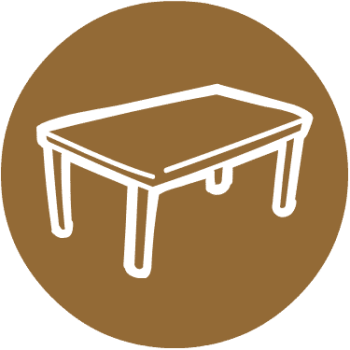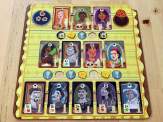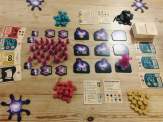| Release Date: 2025 | Players: 1-2 |
| Designer: Nick Warren | Length: 90-120 minutes |
| Artist: Filippo Gallo, Nick Warren | Age: 12+ |
| Publisher: self-published | Complexity: 3.0 / 5 |
| Plastic (by weight): unknown | Air (by volume): unknown |
On a remote island in the middle of the Boiling Sea, two factions build their fortresses, facing each other at opposite ends of the battlefield. They suppress their enemy while searching for two ancient crystals which promise great power. Whoever can find the crystals first will be able to summon an almighty dragon and launch their final attack and obliterate their mortal enemy’s Crimson Keep a self-published game by Nick Warren with art from Filippo Gallo.
Listen to the Audio Version
Intro Music: Bomber (Sting) by Riot (https://www.
Music: “Endurance” by AShamaluevMusic.
Website: https://www.
Music by https://www.
License code: FDY6UJCUWL7OZ1RK
Labour of Love
When you’re sent a prototype for review and receive what looks like a production copy, you know you’re dealing with someone’s passion project. It is rare that a publisher sends you a refined version of their game when it hasn’t yet been released.
The review copy of Crimson Keep I received came with a bifold game board made from thick cardboard, two dual-layer player boards, a tuck box with a magnetic lid for each player to hold their deck of cards, tokens and gorgeous dice, a small cloth bag, custom wooden counters in the shape of a dragon head and thick cardboard tokens. The game box itself is beautifully illustrated on the inside as well as the outside, every card has its own unique illustration and the game board and rulebook don’t skimp on artwork either.
Additionally, the players’ components mirror each other. The illustrations on the cards are flipped left to right to face each other. Similarly, the tuck boxes have the dice on opposite sides for each player. Even the player boards are mirrored. So even if you’re colour blind, you will know which side of the board the components should go. It’s a level of detail that I’ve not seen in other games before.
Just beware that Crimson Keep uses up a lot of space. The game board is huge to allow room for the two keeps, which will eventually grow to five cards high by three cards wide. Add your player boards on either side and you end up using up the whole table. So be aware of its size and make sure you have room to play it.

Towers and Battles
Crimson Keep is a symmetrical action-selection and tableau-building game where both players have the same deck of cards. Most of the time, you play cards from your hand. Building cards go on the game board to build your keep, battle cards go into your barracks on your player board, from where they can enter the battlefield, while cavern cards also go on your player board and are boosters to buff other actions and abilities.
You build the keep literally in 2D, starting at the bottom of the game board and adding more cards above to build up your column or to one side to widen it. Each player builds their keep at their end of the game board, facing their opponent, with the battlefield between them.
The battlefield is where you place one of your battle cards from your barracks and then move it towards your opponent’s keep. Your opponent will most likely play one of their battle cards to greet your warrior and to protect their keep. The reason for this is that if you are able to get your battle card through to your opponent’s keep and successfully attack it, you can cause the whole column of cards to topple. That can be devastating, especially in the latter part of the game when your opponent will have filled all three columns all the way to level five. It is a mechanism I haven’t seen in other games and creates a constant threat that you have to protect yourself against.
Battles themselves are resolved using dice rolls, attack and defence tokens and battle cards that add together to an attack or defence value. Whoever has the higher number wins the battle. They are really quite quick and simple with a small amount of randomness, without being completely luck-based.
Active and Inactive Actions
Another interesting mechanism in Crimson Keep is that cards need to be activated before they can be used. All of the cards are double-sided: one side is inactive, the other active. Every card enters the game on its inactive side. That’s not much of a problem, but to use a card, you need to activate it first. For example, while you can move a battle card towards your opponent while it’s inactive, you can only attack with it after it has been flipped to its active side. Similarly, cavern cards and cards with special abilities can only be used when active and are flipped back to their inactive side afterwards.
That leads me nicely to the action-selection part of Crimson Keep. Everything you do is an action and you have two actions on your turn. There are three main action tracks. One is for playing cards, another for flipping cards to their active side and the third for using a card’s special ability or to attack. The clever bit is that every time you use an action, you move a dragon head counter one space along that track. Once the dragon token has reached the end of the track, you get a more powerful free action that you can use any time – either on this turn or a future turn. Once you’ve used the free action, you move the counter back to the beginning of its track.
The action tracks create a clever timing element in Crimson Keep and encourage you to do the same action repeatedly so that you move up the track more quickly. It’s like charging up your power move in a computer game. Time it right and you get an extra powerful action at the perfect moment that can make a big difference.

Summoning Dragon Runes
However, the ultimate goal in Crimson Keep is to collect runes, which eventually allow you to summon your dragon. Each rune is a mini-objective. For example, you get a rune when you have filled the bottom two rows of your keep, or when your barracks have three cards in them.
Each rune is worth a certain number of points. When the total rune value reaches a certain threshold and you have three special cards placed into your keep, you are ready to summon the dragon.
Just be careful. The strength of the dragon is linked to the value of the runes. Ideally, you want to have collected all the runes to be able to summon the most powerful beast. However, if you wait too long, your opponent may be ready to summon their dragon before you. It’s a bit of a race and a matter of timing it right and gauging what your opponent might be planning.
Once a player has decided to summon their dragon, Crimson Keep enters the end game and the final battle begins. From now on, the player with the dragon places four cards into the centre of the battlefield. The artwork on these cards is done in such a way that the four cards combine to make up the dragon, which covers up the monolith in the centre four spaces, but still shows the background. It’s a bit hard to describe, but a wonderful visual touch that you will really appreciate when you get to this stage of the game.
Final Battle
The final battle is the all-deciding fight and lasts up to four rounds, during which the dragon attacks. If it fails, one of the four dragon cards is flipped over to show the dragon wounded by arrows, which is another wonderfully visual detail that makes Crimson Keep so much fun to play. If the dragon succeeds in its attack, one of the three columns of the opponent’s keep collapses. All of the cards are removed from the board, another visual way of showing how the tower is weakened.
While you might think that the dragon is bound to win, it’s not a given. Even the most powerful dragon will struggle against an especially strong keep. If the opponent’s tower has mostly active cards in it, especially active special summoning cards, it will be able to withstand a lot of damage. So you can never be sure when the time is right to launch the final attack, but eventually your hand is forced and the end is nigh.
The final battle is the peak of the story arc that players have lived through during their game of Crimson Keep. You can really see the progress of your keep and armies in front of you. After slowly building up your keep and sending out warriors to weaken your opponent, you were eventually able to collect enough runes to summon your dragon. You have gone through a long, hard slog to finally reach the end. It’s the last stand after which the better player will win.
Crimson Keep is an epic game, not just because of its physical size, visual presentation and gorgeous production, but also in the gameplay and mechanisms. You need to play it multiple times to master it. It’s a two-player battler like no other I’ve seen.
Keeping the blog running takes time and resources. So if you can chip in, that would be amazing.
Useful Links
- Crimson Keep: https://www.
crimsonkeep. co. uk/ - Crowdfunding page: https://www.
kickstarter. com/ projects/ 1434461475/ crimson-keep-a-strategy-board-game - Rulebook: https://www.
crimsonkeep. co. uk/ _ files/ ugd/ dca619_ dda17b77b07a43058fa961211b035173. pdf - BGG listing: https://boardgamegeek.
com/ boardgame/ 428015/ crimson-keep
Videos
Transparency Facts
I feel that this review reflects my own, independent and honest opinion, but the facts below allow you to decide whether you think that I was influenced in any way. Please also read my Ethics Statement for more information.- I was given a free review copy of this game by the publisher.
- At the time of writing, I have not received financial support from the publisher or anyone working on their behalf.
Audio Version
Intro Music: Bomber (Sting) by Riot (https://www.
Music: “Endurance” by AShamaluevMusic.
Website: https://www.
Music by https://www.
License code: FDY6UJCUWL7OZ1RK
Playlist
These are the songs I listened to while I was writing this review:







Amazing, thank you so much Oliver for this wonderful review 🙏 It was a pleasure to meet you at the UKGE and to see you passion fory small indie game ☺️ I am so pleased and honoured that your daughter wanted to play Crimson Keep with you.
No problem. I have to thank you for making such an amazing game.